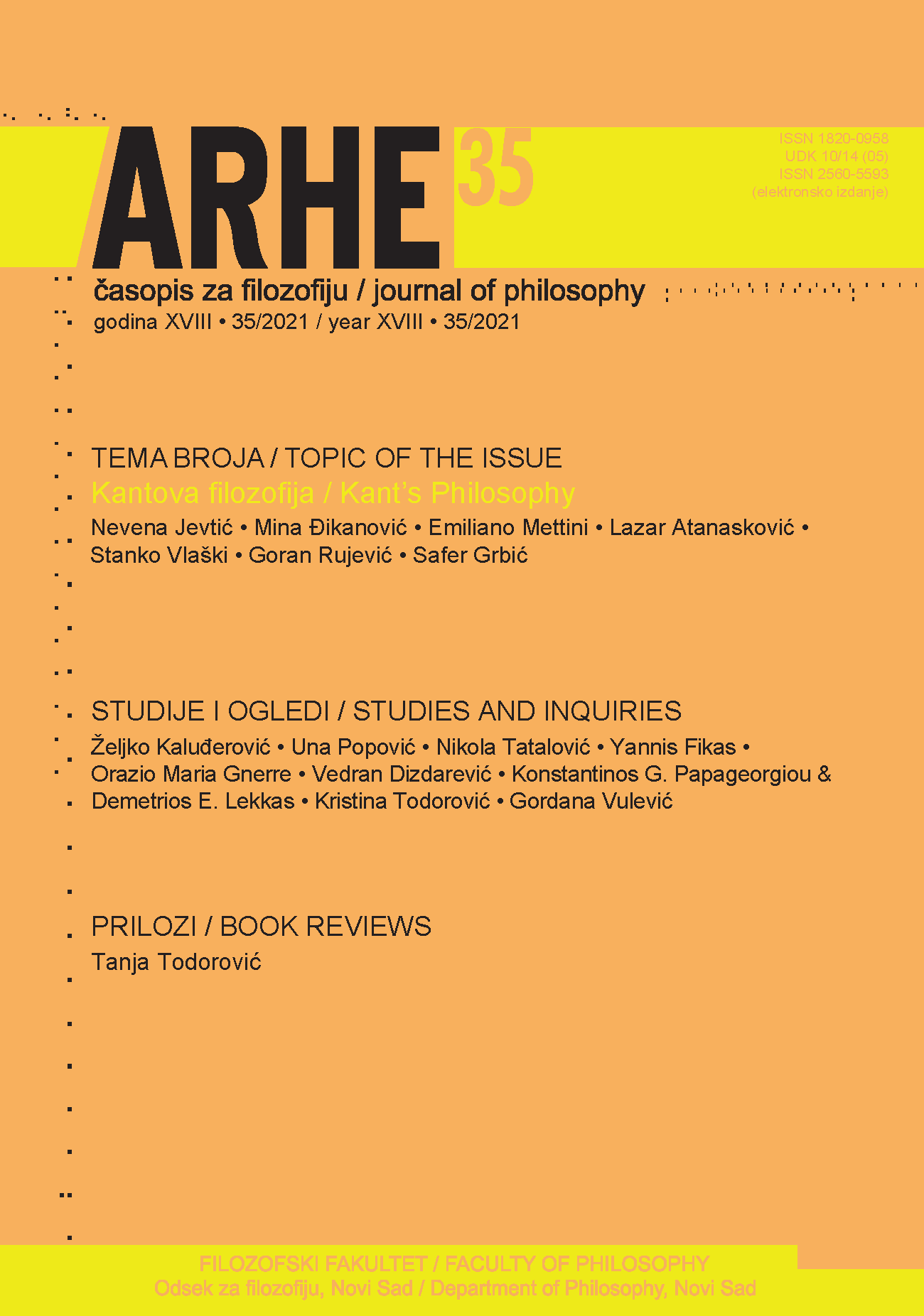GADAMER'S "REPETITION" OF MIMESIS I
Main Article Content
Abstract
The research follows the basic characteristics of Gadamer's rehabilitation of the concept of mimesis, which is of crucial importance for the development of the whole of his project of philosophical hermeneutics. The research points to the underlying assumptions that guide Gadamer’s return to the “original” sense of mimesis. Analyzing Gadamer's understanding of the notion of play, transformation into the structure and temporal character of a work of art, the research seeks to point out the fundamental dependence of Gadamer's notion of mimesis on the Platonic tradition, primarily Neoplatonism. Given the Platonic game of understanding of mimesis, which moves through the conflict of truth as correspondence and truth as self-showing of being, analyzes ultimately show that Gadamer returns to mimesis without actually repeating mimesis, and points to the need to abandon the notion of truth if indeed we want to repeat mimesis. The first part of the research, presented in this paper, aims to conduct most of the aforementioned analyzes in order to explain in detail in the second part of the research the previously pointed out conclusion regarding the character of Gadamer's notion of mimesis.
Article Details
References
“A Conversation With Hans-Georg Gadamer”, Method. Journal of Lonergan Studies, 1990, intervju (Michael Baur), str. 1-13.
Cassirer, E., “Eidos und Eidolon. Das Problem des Schönen und der Kunst in Platons Dialogen”, u: Vorträge der Bibliothek Warburg, II. Vorträge 1922–1923 / I. Teil, (1924), str. 1-27. DOI: https://doi.org/10.1007/978-3-663-15764-9_1
de Man, P., „Retorika temporalnosti”, u: Problemi moderne kritike, Nolit, Beograd, 1975., str. 236-284.
Deleuze, G., „Platon i simulakrum”, u: Logika smisla, Sandorf & Mizantrop, Zagreb, 2015., str. 228-238.
Delez, Ž., Razlika i ponavljanje, Fedon, Beograd, 2009.
Derida, Ž., „Ekonomimezis”, Treći program, br. 112 (2001), str. 175-208.
Derida, Ž., Bela mitologija, Bratsvo-Jedinstvo, Beograd, 1990.
Derrida, J., “The Double Session”, u: Dissemination, The Athlone Press, London, 1981., str. 173-286.
Dostal, R., “Gadamer’s Platonism: His Recovery of Mimesis and Anamnesis”, u: Consequences of Hermeneutics. Fifty Years After Gadamer's Truth and Method, J. Malpas (ur.), Northwestern University Press, 2010., str. 45-65. DOI: https://doi.org/10.2307/j.ctv47w3wx.7
Else, Gerald F., “‘Imitation’ in the Fifth Century”, u: Classical Philology, Vol. 53, No. 2 (1958), str. 73-90. DOI: https://doi.org/10.1086/364238
Elsner, J., “Between Mimesis and Divine Power. Visuality in the Greco-Roman World”, u: Visuality before and Beyond the Renaissance. Seeing as Others Saw, R. S. Nelson (ur.), Cambridge University Press, Cambridge, 2000., str. 45-66.
Fink, E., Igra kao simbol svijeta, Demetra, Zagreb, 2000.
Gadamer, H.-G., “Die Aktualität des Schönen. Kunst als Spiel, Symbol und Fest”, u: Gesammelte Werke, Bd. 8, Mohr Siebeck, Tübingen, 1993, str. 94-142.
Gadamer, H.-G., “Einleitung”, u: Die Lektion des Jahrhunderts. Ein philosophischer Dialog mit Riccardo Dottori, Lit Verlag, Münster, Hamburg, London, 2002., str. 3-21.
Gadamer, H.-G., „Pesništvo i mimezis”, u: Filozofija i poezija, Službeni list SRJ, Beograd, 2002, str. 33-38.
Gadamer, H.-G., „Platon kao portretist”, u: Čitanka, Matica hrvatska, Zabgreb, 2002., str. 235-256.
Gadamer, H.-G., „Pohvala teoriji”, u: Pohvala teoriji, Oktoih, Podgorica, 1996., str. 5-25.
Gadamer, H.-G., „Riječ i slika – ‘tako istinito, tako zbiljsko’”, u: Čitanka, Matica hrvatska, Zagreb, 2002., str. 198-228.
Gadamer, H.-G., „Tekst i interpretacija”, u: Čitanka, Matica hrvatska, Zagreb, 2002., str. 165-197.
Gadamer, H.-G., Istina i metoda. Osnovi filozofske hermeneutike, Veselin Masleša, Sarajevo, 1978.
Gonzalez, F. J., “The Philosophical Use of Mimēsis”, u: The Many Faces of Mimēsis. Selected Essays from the 2017 Symposium on the Hellenic Heritage of Western Greece, Heather L. Reid, Jeremy C. DeLong (ur.), Parnassos Press, Sioux City, 2018., str. 23-36. DOI: https://doi.org/10.2307/j.ctvbj7g5b.5
Gronden, Ž., Uvod u filozofsku hermeneutiku, Akademska knjiga, Novi Sad, 2010. str. 164.
Hajdeger, Martin, Niče, I, Fedon, Beograd, 2009.
Halliwell, S., “Plato and Painting”, u: Word and Image in Ancient Greece, N. K. Rutter, B. A. Sparkes (ur.), Edinburg University Press, 2000., str. 99-118. DOI: https://doi.org/10.3366/edinburgh/9780748614066.003.0007
Halliwell, S., The Aesthetics of Mimesis. Ancient Texts and Modern Problems, Princeton University Press, Princeton, 2002. DOI: https://doi.org/10.1515/9781400825301
Kasirer, E., Kant. Život i učenje, Hinaki, Beograd, 2006.
Keuls, E., Plato and Greek Painting, Brill, Leiden, 1978. DOI: https://doi.org/10.1163/9789004450776
Kisiel, T., “Repetition in Gadamer's hermeneutics”, u: The Late Husserl and the Idea of Phenomenology. Idealism-Realism, Historicity and Nature, A.-T.Tymieniecka (ur.), D. Reidel Publishing Company, Dordrecht, 1972., 196-203. DOI: https://doi.org/10.1007/978-94-010-2882-0_16
Kjerkegor, S., Ponavljanje, Grafos, Beograd, 1982.
Koller, H., Die Mimesis in der Antike. Nachahmung, Darstellung, Ausdruck, A. Francke, Berne, 1954.
Lacoue-Labarthe, P., “Typography”, u: Typography. Mimesis, philosophy, politics, Harvard University Press, London, 1989., str. 43-138.
Melberg, A., "Repetition (In the Kierkegaardian Sense of the Term)", Diacritics, Vol. 20, No. 3 (1990), str. 71-87. DOI: https://doi.org/10.2307/465332
Melberg, A., Theories of mimesis, Cambridge Univerisity Press, New York, 1995. DOI: https://doi.org/10.1017/CBO9780511597732
Nightingale, A. W., Spectacles of Truth in Classical Greek Philosophy. Theoria in its Cultural Context, Cambridge University Press, New York, 2004. DOI: https://doi.org/10.1017/CBO9780511482564
Pippin, R., “Gadamer’s Hegel”, u: Gadamer’s Century. Essays in Honor of Hans-Georg Gadamer, J. Malpas, U. Arnswald, J. Kertscher (ur.), The MIT Press, Cambridge, 2002., str. 217-238. DOI: https://doi.org/10.1017/CCOL0521801931.011
Platonis Opera. Recognovit brevique adnotatione critica instruxit Ioannes Burnet. Toms I-V, Oxford, 1966.
Plotin, Eneada III, IV, VI, Književne novine, Beograd, 1984.
Popović, U., „Lepe umetnosti i podražavanje: Bateovo određenje modernog pojma umetnosti”, Arhe, 14, 28 (2018), str. 157-171.
Popović, U., „Platonova kritika umetnosti iz perspektive obrazovanja”, Arhe, VII, 13 (2010), str. 129-147.
Rausch, H., Theoria. Von ihrer sakralen zur philosophischen Bedeutung, Wilhelm Fink, München, 1982.
Ricoeur, P., “Temporal Distance and Death in History”, u: Gadamer’s Century. Essays in Honor of Hans-Georg Gadamer, J. Malpas, U. Arnswald (ur.), The MIT Press, Cambridge, 2002., str. 239-256.
Riker, P., Vreme i priča, I, IKZS, Sremski Karlovci, 1993.
Risser, J., “Hermeneutic Experience and Memory: Rethinking Knowledge as Recollection”, Research in Phenomenology, Vol. 16 (1986), str. 41-55. DOI: https://doi.org/10.1163/156916486X00031
Schweiker, W., “Beyond Imitation: Mimetic Praxis in Gadamer, Ricoeur, and Derrida”, u: The Journal of Religion, Vol. 68, No. 1 (1988), str. 21-38. DOI: https://doi.org/10.1086/487713
Schweiker, William, Mimetic Reflections. A Study in Hermeneutics, Theology, and Ethics, Fordham University Press, New York, 1999.
Tatalović, N., „Gadamerova hermeneutička ontologija”, Arhe, IX, 17 (2012), str. 139-153.
